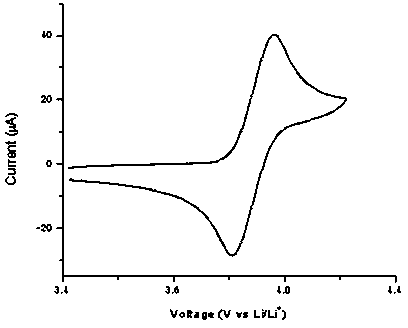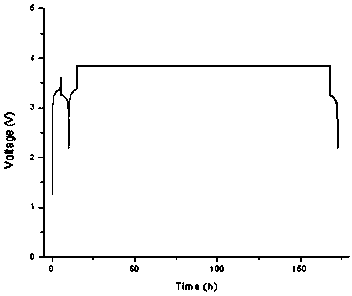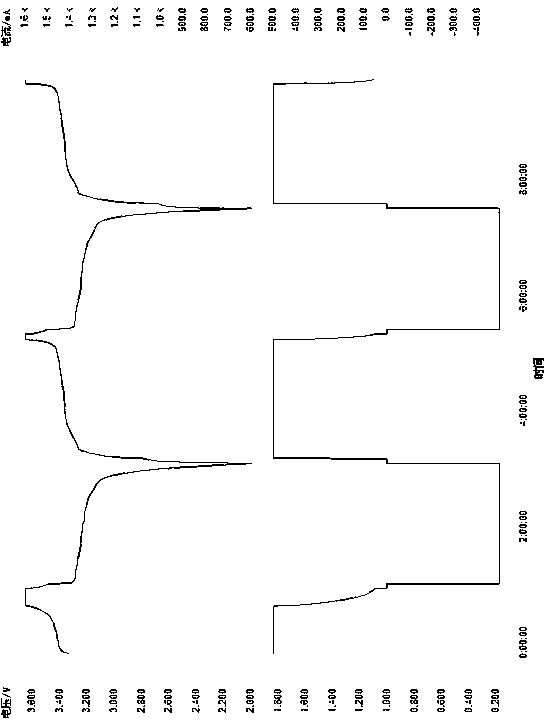Lithium ion battery redox couple additive and lithium ion battery electrolyte
A technology of lithium-ion batteries and additives, applied in the direction of secondary batteries, electrochemical generators, secondary battery repair/maintenance, etc., can solve the problem that the overcharge protection ability cannot meet the actual use requirements, and the additives can meet the actual application requirements , No overcharge protection time and other issues are provided to avoid thermal instability or even burning, avoid early scrapping, and improve overcharge safety performance
- Summary
- Abstract
- Description
- Claims
- Application Information
AI Technical Summary
Problems solved by technology
Method used
Image
Examples
Embodiment 1
[0041] The structural formula of the lithium-ion battery redox pair additive is as follows:
[0042]
[0043] Its preparation method is: under the protection of nitrogen, add 2,3,5,6-tetramethylhydroquinone (0.2 mmol) in tetrahydrofuran (20 mL) to sodium hydride (0.6 mmol) in tetrahydrofuran (20 mL) In suspension, the resulting mixture was stirred at room temperature for 20 minutes. 2-Methoxyethoxychloromethane (0.4 mmol) was slowly added to the above mixture, and the resulting solution was stirred overnight (12 h) at room temperature. The mixture was cooled to 0°C in an ice bath, slowly added saturated ammonium chloride aqueous solution (50 mL) under stirring, transferred to a separatory funnel, oscillated, allowed to stand still, separated into layers, and the organic phase was collected. The aqueous phase was extracted with dichloromethane (50 mL x 3). The organic phases were combined and dried over anhydrous sodium sulfate. The solvent was removed by rotary evaporati...
Embodiment 2
[0045] The structural formula of the lithium-ion battery redox pair additive is as follows:
[0046]
[0047] Its preparation method is: under the protection of nitrogen, add 2-ethyl-3,5-dimethylhydroquinone (0.2 mmol) in tetrahydrofuran (20 mL) to sodium hydride (0.6 mmol) in tetrahydrofuran (20 mL ) suspension, and the resulting mixture was stirred at room temperature for 20 minutes. 2-Methoxyethoxychloromethane (0.4 mmol) was slowly added to the above mixture, and the resulting solution was stirred overnight (12 h) at room temperature. The mixture was cooled to 0°C in an ice bath, slowly added saturated ammonium chloride aqueous solution (50 mL) under stirring, transferred to a separatory funnel, oscillated, allowed to stand still, separated into layers, and the organic phase was collected. The aqueous phase was extracted with dichloromethane (50 mL x 3). The organic phases were combined and dried over anhydrous sodium sulfate. The solvent was removed by rotary evapor...
Embodiment 3
[0049] The structural formula of the lithium-ion battery redox pair additive is as follows:
[0050]
[0051] Its preparation method is: under the protection of nitrogen, add 2,3,5,6-tetramethylhydroquinone (0.2 mmol) in tetrahydrofuran (20 mL) to sodium hydride (0.6 mmol) in tetrahydrofuran (20 mL) In suspension, the resulting mixture was stirred at room temperature for 20 minutes. 2-Methoxychloroethane (0.4 mmol) was slowly added to the above mixture, and the resulting solution was stirred overnight (12 h) at room temperature. The mixture was cooled to 0°C in an ice bath, slowly added saturated ammonium chloride aqueous solution (50 mL) under stirring, transferred to a separatory funnel, oscillated, allowed to stand still, separated into layers, and the organic phase was collected. The aqueous phase was extracted with dichloromethane (50 mL x 3). The organic phases were combined and dried over anhydrous sodium sulfate. The solvent was removed by rotary evaporation, and...
PUM
 Login to View More
Login to View More Abstract
Description
Claims
Application Information
 Login to View More
Login to View More - R&D
- Intellectual Property
- Life Sciences
- Materials
- Tech Scout
- Unparalleled Data Quality
- Higher Quality Content
- 60% Fewer Hallucinations
Browse by: Latest US Patents, China's latest patents, Technical Efficacy Thesaurus, Application Domain, Technology Topic, Popular Technical Reports.
© 2025 PatSnap. All rights reserved.Legal|Privacy policy|Modern Slavery Act Transparency Statement|Sitemap|About US| Contact US: help@patsnap.com



